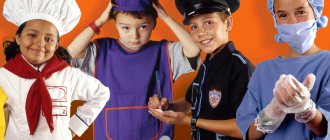What does a pastry chef bake, or what types of buns and pies are there?
Unbutton. What word does the name of the pie resemble? (For the word “unbutton, unfasten”) Such pies are called rasstegai because they have an open middle from which the filling peeks out. It's like the pie has come undone.
Saika. Oval shaped bun. There may be several of them “stuck” to each other.
Bagel. Look at the bagel. Why do you think people named this bun that? (similar in shape to a horn)
Bun. The name of the bun “bun” comes from the word “to flatten.” Do you remember how you flatten a ball of plasticine into a cake? This bun is flat as if it was flattened. So they call it a bun.
Network. And the braid is woven when it is cooked. Have you already guessed how it is woven? You can braid it like a braid, or you can twist the ends differently. You can try making a braided rope from plasticine. Try to invent your own way of weaving braids.
Cheesecake. What shape is the cheesecake? That's right, it's always round. Have you gone on a cheesecake slide down the hill in winter? Or have you seen others ride? How are a cheesecake for sliding downhill and a cheesecake - a bun?
Donut . Round fried sweet pie. Sometimes it is also called crumpet. Have you already guessed why? He's lush. plump.
What are discharges and why are they needed?
This characteristic of the chef profession, like ranks, as for professional athletes, serves as an indicator of skill. There are 5 categories in total, of which the 2nd is the lowest. Specialists with this rank are engaged in sorting, cleaning and washing greens, vegetables and fruits, cutting and preparing fish, poultry and meat for processing.
Chefs of the 3rd category are entrusted with the preparation, decoration and portioning of easy-to-prepare dishes.
Professionals of the 4th category prepare culinary products and dishes of average complexity.
Chefs of the 5th category are masters of their craft, who can prepare and beautifully prepare almost any dish, even the most complex.
Necessary personality qualities
No one will argue with the statement that a cook is a good profession, just like a singer, pilot or teacher. But to work in each of these specialties you must have certain personal characteristics. For a specialist in the culinary arts, it is important to combine scrupulous precision and rich creative imagination, excellent memory and high creativity. Attention, accuracy and a high level of organization characterize a high-level specialist. For a chef striving to reach the pinnacle of professional excellence, endurance is required, combined with a high level of stress resistance, since he will have to work in rather difficult conditions for 10-12 hours a day. In addition, those who know how to work in a team will be able to adapt faster and develop their culinary skills and abilities.
From mammoths to the present day...
The first cook in human history was a primitive hunter who accidentally fried a piece of his catch over a fire. The cavemen, having tasted the meat prepared in this way, began to constantly fry it over the fire. And quite soon, using the trial and error method, they found out that for some the mammoth turns out to be juicy and tasty, while for others it is completely inedible. Of course, they began to trust the cooking to the one who turned out tastier. In this way, or approximately in this way, the profession of a cook was born.
However, the first culinary professionals who made a living by cooking for others were Cretan cooks hired to cook for the king's soldiers around 2000 BC. e. Already in Ancient Rome, many rich and noble townspeople preferred to entrust food preparation to special people who knew how to cook, rather than to slaves. It was in Rome that the then famous gourmet and cook Apicius created the first cooking schools.
The rulers of Ancient Persia highly valued delicious food, and cooks who managed to surprise the eastern rulers with an unusual dish were generously rewarded. However, there were other traditions, for example, in Sparta, the art of cooking and the profession of a cook were treated with contempt, considering all this to be excesses.
The history of the chef profession has seen both periods of dizzying ups and stagnation. After a long period of stagnation, only at the end of the Middle Ages, during the time of great discoveries, when a variety of oriental herbs and spices began to penetrate into European countries, culinary art began to develop rapidly. Since then, there has been constant culinary rivalry between Italy and France. Not only professional cooks, but also pundits and even statesmen took part in the development of the art of cooking. Cardinals Mazarin and Richelieu created new dishes, and the great philosopher Michel Montaigne wrote an entire treatise, “The Science of Food.” Modern Italian restaurants still serve dishes invented by the great composer Rossini, and the French are proud of the contribution to national cuisine of Honore de Balzac and Alexandre Dumas the Father.
In the 19th century, most European countries created courses that taught culinary arts.
Russian classification
She divides all cooks into four types:
- Cook-technologist who receives raw materials and controls their quality. His responsibilities also include calculating the required amount of food per serving and organizing the technological process of preparing the dish. He also comes up with and develops recipes for new dishes, draws up technological maps for them and instructions for those who will prepare them.
- The culinary chef cuts meat and fish, preparing them for cooking, cuts vegetables, kneads the dough and directly prepares the dishes, as well as checks their readiness and decorates them before serving.
- A pastry chef specializes in making desserts and confectionery. He fully executes the recipe, controlling taste and visual parameters, and also decorates sweet dishes before serving them.
- Being a chef is the pinnacle of a professional career. This is not only an expert culinary specialist, but also an excellent administrator. He is obliged to form the menu of the establishment, compose and order the necessary products and goods, control the quality and timing of their delivery, organize and improve the work of all other cooks, and monitor compliance with the cooking technology.
Confectioner's profession. Educational games
In games, a preschooler learns to creatively use the knowledge about the profession that he has received.
Game "Fourth wheel"
Find the extra picture. Explain why it is superfluous (a picture that has nothing to do with the pastry chef’s profession will be superfluous in this game). How can you call everything that is shown in the pictures in one word? (food)
Card 1.
Card 2.
Card 3.
Guess game
This game can be played with a child 6-7 years old and older. This is how they play it. The presenter talks about himself on behalf of some product. For example, on behalf of the flour, he talks about how it was made, how it was packaged, how people will use it, what the confectioner will do with it. And the rest of the players guess which product the presenter spoke on behalf of. A very exciting game, but difficult for children. Children play it when they hear interesting and funny stories from adults. It's usually the dads who come up with the most interesting stories, not the moms!
Where to go to study?
Where can I become a chef? Today, unlike in previous times, a person who decides to devote his life to cooking can take several paths. First of all, the path is standard: after finishing the 9th or 11th grade of a general education school, enter a college or technical school, where you can receive a secondary specialized education as a cook. Technical schools, as a rule, train technologists for public catering enterprises and food production. After receiving your main specialty, you can improve your qualifications and undergo industrial training. The profession of a pastry chef or a specialist in any national cuisine is more interesting and promising. You can also continue your education in the future and reach new career heights by enrolling in universities that train higher-class specialists.
Another option: complete paid culinary courses that have state registration, ones that can confirm your qualifications with a diploma, and then get a job in a restaurant or cafe. At first, most likely, you will be an assistant cook, but if you prove yourself, career growth will not be long in coming.
Popular message topics
- Architecture of St. Petersburg
St. Petersburg is considered the first cultural capital of the vast country of Russia. Thanks to Peter 1, who decided to create a large, beautiful city, the architecture of St. Petersburg contains many European styles. It contains a lot - Visible music (what is Visible music)
The connection between music and fine arts has always existed - musicians often became objects of artists’ works (the paintings “Three Girls Playing Music”, “Lute Player”, “Guitar Player”, etc.) However, the concept of “visible music” - Hamsters
Hamsters are a species of rodent that attracts almost all young children. They live in almost all parts of our world. Thus, there are not only domestic rodents, but also predatory ones.
Who makes the buns? Preschoolers about the profession of a pastry chef
Ask your child if he knows where the buns in the store come from? Who bakes them? Most likely, the child will answer that the cook bakes the buns. Fix it. This man is a pastry chef by profession .
Invite your child to listen to two poems and guess how the professions of a cook and a pastry chef differ.
The cook cooks soup, potatoes, and cutlets for the child. Prepares semolina porridge, salad with sour cream.
I will bake pies, and gingerbread, and horns. This is the gift I have: I am a pastry chef.
What does a chef cook and what does a pastry chef cook? (The pastry chef prepares sweet buns, cookies, gingerbreads, cakes, pastries, cheesecakes, candies, buns... The cook prepares porridge, salads, main dishes, compote, cutlets...)
Find the cook and pastry chef in the picture.
Guess my riddle:
Walks around in a white cap
with a ladle in hand
He's cooking us lunch
Porridge, cabbage soup and vinaigrette.
Who is this - a cook or a pastry chef? Why?
Look at the picture.
- What does a pastry chef wear before work? Why does a pastry chef need a robe and a cap on his head? (A cap is needed to cover the hair, otherwise the hair may get into the baked goods. An apron or robe is needed to protect clothes, because something can get on it and ruin it. An apron or robe is also needed to prevent dirt, dust, and threads from clothing got into the food).
- Why is the chef's and pastry chef's robe always light and never dark? (The robe must be clean so that dirt does not get into the food. Dirt is not visible on a dark robe. Therefore, the cook and pastry chef always wear snow-white clothes)
How do confectioners work? Journey to the confectionery shop
And now a funny cartoon about the work of confectioners awaits you. You will see how buns are baked in a real factory. You will also learn the story about one famous Russian confectioner and the one who invented raisin buns.
Preschoolers cannot get into a real confectionery shop, so the opportunity to find themselves in one thanks to a video is an opportunity that should not be missed! You must see all this with your own eyes!
The video and cartoon are so interesting and funny that I highly recommend everyone to watch it, even adults - you will learn a lot of new things and get a charge of optimism and a great mood! Enjoy watching!








